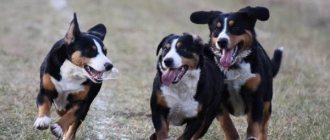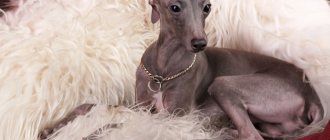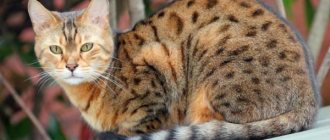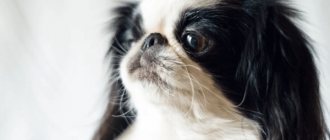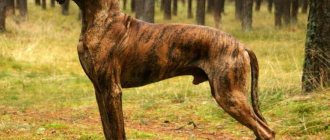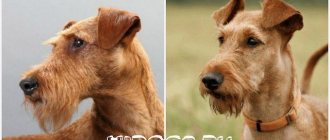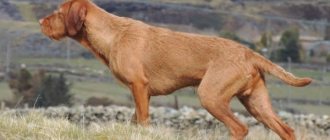Learn about the Chesapeake Bay Retriever's character and personality. Study his habits, traits, characteristics and how he generally behaves. Find out what kind of care he needs and how easy it is to train him.
| Easy to train |
| Quick wits |
| Hair loss |
| Will raise the alarm |
| Will protect |
| Popularity |
| Size |
| Dexterity |
| Friendly with children |
History of the Chesapeake Bay Retriever
In 1807, the commander of the ship that saved a sinking yacht in Maryland received two dogs that looked very similar to Newfoundlands as gratitude. Due to the fact that these dogs had excellent water skills, they were actively used as duck hunters in the Chesapeake Bay (USA).
Later, it was decided to improve the representatives of this breed. As a result of breeding activities, the blood of setters, coonhounds, and retrievers began to flow in their veins. According to some reports, Irish water spaniels also participated in the creation of a new type of dog. The selection process was completed by the mid-19th century, resulting in the Chesapeake Bay Retriever breed.
Its first representative was registered in 78 of the 19th century. The breed club opened its doors to the breed only 39 years later. In 1964, the Chesapeake was proclaimed the official symbol of the American state of Maryland.
In our country, this type of retriever is not yet as popular as the Golden and Labrador. However, this type of dog is constantly evolving. When pronouncing the name of representatives of this breed, the prefixes “beat” and “retriever” are often omitted.
Origin story
In 1807, a ship sank off the coast of Maryland, from which, among other things, two puppies were rescued. They were described as Newfoundlands, but were much smaller in size, so they looked more like St. John's water dogs. The puppies were of different sexes and eventually settled in different parts of the Chesapeake Bay. As far as is known, they did not produce a joint litter, but working with their offspring separately, including hound and spaniel blood, resulted in a stock of good hunting dogs. They had the natural talents of a retriever, a waterproof coat, a high level of obedience and a loyal disposition. By 1877, three types of retrievers had been identified on the coast. In 1918, one of them was recognized by the American Kennel Club as the Chesapeake Bay Retriever.
In 1964, the Chesapeake Bay Retriever was declared the national breed of Maryland. Additionally, the brown dog is the mascot of the University of Maryland, Baltimore County.
Purpose
The Chesapeake Bay Retriever was bred on the east coast of Chesapeake Bay to hunt waterfowl in the most adverse weather conditions. The coat, temperament and physical characteristics allow the dogs to work easily and efficiently with their characteristic endurance.
The Chesapeake Bay Retriever was bred to hunt waterfowl in adverse weather conditions. If necessary, the dog will break the ice, but will get the prey.
First of all, the Chesapeake is, of course, a hunter and retriever by vocation. But he is also a loyal companion and a capable athlete, who can be seen in agility, obedience and diving competitions. Frisbee is not the best choice. Physically, the robust Chesapeake Bay Retriever is not suited for constant jumping and is not as light or agile as needed. You may get injured, which you won’t immediately know about.
Video about the Chesapeake Bay Retriever dog breed:
Who is it suitable for?
The character of the independent Chesapeake Bay Retriever is characterized by independence. The dog simply needs it when searching for game, because no one will tell it how to find downed prey. To properly raise a Chessie, you need a strong hand and unquestioned authority. Therefore, the owner of the breed should be an experienced dog lover, preferably a hunter.
Retriever puppies need to be socialized as early as possible: introduced to a large number of other dogs, other animals and people, and taken with them to visit places other than their permanent home conditions.
The wool lubricant inherent in the breed has a specific odor. Considering this factor and its considerable size, the best living conditions for a dog are a country house with a courtyard. Here it is easier to realize the potential of an animal that needs more space for active games and jogging. A Chesapeake Bay Retriever can do a lot of damage to an apartment without having an outlet for its energy. This breed is unlikely to be suitable for a passive owner who does not give the retriever proper exercise.
We suggest you familiarize yourself with: American Shorthair cat - kisa.su
Chessie is recommended for families with older children, with whom the breed gets along well. However, contact between young children and the retriever must be supervised.
The character of a retriever, if it is properly trained, is friendly, accommodating, playful, persistent when searching for game. If other dogs hunt for the owner, then the Chessie has this property of nature: be sure to find and bring. At the same time, an intelligent animal does not finish off the game and does not eat it.
Caring for the Chesapeake
Add "WOOF!" 0
| Type | |
| Size | large (26-50kg) |
| Main features |
|
| Included in |
|
| Intelligence | 65% |
| Price for Chesapeake Retriever puppies Reviews All dog breeds |
You will have to take care of the dog's fur. She loses a fair amount of it, so you need to be prepared for the fact that she can be found everywhere. Therefore, during shedding, you can brush the coat a couple of times a week. This will rid your house of a fair amount of it. The most common disease is hip dysplasia.
A hunting dog should have a balanced diet. The puppies' menu should consist of foods high in protein and calcium. They also need vitamins. By nature, Chesapeakes are omnivores and can eat a lot. Therefore, they may suffer from overeating and, as they grow older, will become more picky about food. Give your pet food in small portions.
When forming a pet’s diet, proceed from its physical activity and the animal’s parameters (height, weight).
You can feed both natural food and dry food. Or combine human food with canned food.
Coat color is all shades of brown, even straw. But, the preferred color is one that resembles the color of withered grass. White spots on fingers and chest are acceptable. Its height is 58-66 cm, and the weight of an adult dog is 29-34 cm.
A brave, unpretentious, excellent swimmer, the dog has a calm character, pleasant and flexible. Can play the role of a watchman. When training, it needs a “steady hand.”
The dog is fully developed and loves to be the center of attention of a family leading an active lifestyle. Their character is protective and dominant, which on the one hand can be considered a blessing, but on the other hand can become a real problem for the owners. Therefore, it is not recommended for beginners to get such a dog, which requires a strong hand.
These are excellent watchdogs, but they need to be accustomed to society from an early age so that the dog does not grow up aggressive. They are fast and agile, athletically built. Daily training is mandatory for them. They love to play outdoors and in water. Water is their favorite pastime. In addition, this breed of dog needs constant mental stimulation, otherwise it turns into a bored animal, and this is bad news, because a bored dog can turn everything around into ruins, including an apartment. They are tolerant of other dogs, or rather indifferent.
But they have a special closeness with children. A well-trained dog understands perfectly what is expected of it, so it will be incredibly loving, faithful and devoted. They are very sensitive, so they always want to please their loved ones. This unique dog works in any conditions, be it a headwind, icy water, strong current, etc.
At the same time, the Chesapeake Bay Retriever does the job easily and effectively almost until his last days. At one time, when hunting a bird, it can bring 10-20 ducks, and in a day the number can increase to one hundred. Those who are not familiar with this breed consider the dog to be aggressive. But, in reality, she never attacks first, although she does not leave aggression unpunished.
Appearance according to breed standard
The description of the appearance of Chesapeake Retrievers consists of the following characteristics:
- Head. The skull is wide and round. The eyes are medium-sized, oval-shaped, widely spaced. Their color varies from yellow to brownish. The ears are small, of medium thickness, hanging freely. The nose is compact and rectangular in shape. The jaws close like scissors, but a direct version is also acceptable.
- Neck. Powerful, cone-shaped.
- Frame. The back is shortened and muscular. The chest is deep, wide, and cylindrical. The tail is thick, weighted, straight or curved.
- Limbs. Powerful, straight, with solid bones. The fingers are rounded and tightly adjacent to each other.
- Coat. Thick, hard to the touch. The length of the guard hair is about 4 cm. The undercoat layer is compacted and woven. The hair on the face and limbs is shorter than on the body. The coat of Chesapeake Bay Retrievers is water-repellent.
- Color. The coat color of these dogs adapts to their working environment. It comes in all shades of brown and marsh. A solid color is most preferred.
Description of the breed
Appearance of the Chesapeake:
- height – 53-61 cm for females and 58-66 cm for males;
- weight – 25-32 kg (females) and 29-36 kg (males). The unique structure of their coat allows them to stay in cold water for a long time without any threat to their health.
- The wool seems to be covered with a layer of resin, it is very thick, curls at the end, the smell is unpleasant to some, but this particular wool does not allow water and cold to pass through.
- The color of the coat is most often similar to the color of faded grass, but today there are acceptable variations from dark brown to light fawn.
- Eye color – yellow or light brown. This coloring helps the Chesapeake remain invisible to game.
The Chesapeake's ears are thick, short and set high to keep water out when diving. There are membranes between the toes, which help to swim very quickly. The paws are powerful and strong, the tail is long and straight. Powerful jaws with a scissor bite help the Chesapeake to carry heavy game.
Breed standard
The entire body structure of the Chesapeake is designed to make him an ideal hunter, hardy, strong and fast, invisible due to the grass.
Average life expectancy is 10-12 years.
Where to buy a puppy
The price for Chesapeake puppies fluctuates around 30,000 rubles. In Russia, dogs are not officially sold, but there are places where you can still buy a puppy. Dogs are sold mainly by private owners who received offspring from random mating and do not guarantee the breed qualities of the puppies. A high-quality retriever of good blood can only be imported from the USA, so transportation costs will have to be added to the cost.
Be sure to read:
- Black German Shepherd
- St. Bernard dog breed
- Boxer dog
Animal character, education and training
These dogs have very high performance, amazing endurance, fearlessness, balance and amazing ingenuity. Such dogs are characterized by individualism. They are never the first to show aggression towards their brothers, but the Chesapeake will not allow themselves to be offended.
Representatives of this breed are active and cheerful. Such pets are very loyal to their owner. To realize all of these qualities, these animals require socialization and training.
From the first days of his appearance in the house, the four-legged household member must be made clear who exactly is the owner, otherwise he will pretend to be the leader.
In the process of training your pet, you need to show patience and endurance. It is strictly not recommended to yell or resort to coercion if something doesn’t work out for the furry student the first time - these dogs learn commands slowly. To prevent a pet with an innate hunting instinct from trying to chase smaller animals during walks, the dog must first be taught the “near” command.
Rules of care
Caring for retrievers is the same as caring for other dogs.
Wool
The Chesapeake's fur coat is oily, so you need to know some subtleties about its care. There is no need to try to wash the oil out of the wool. The animal needs it as a protective layer. Moreover, the more you try to wash the fur from fat, the more intensely the body will produce it.
Therefore, to clean your pet’s fur coat, use less water and liquid shampoos. The best remedy in this situation is dry shampoo, cleansing lotion or powder. The coat needs to be brushed weekly.
Important! Chesapeake wool
has a specific odor and can cause allergies.
Ears
The animal's ears are droopy and therefore require a lot of attention. The auricle is close to the head, which prevents normal ventilation. Therefore, dirt and sulfur actively collect in it, which must be removed in time, otherwise an inflammatory process may develop.
Eyes
Eyes should be examined regularly. Wipe off dirt and debris with a soft cloth soaked in boiled water. The movement should go from the top corner to the bottom.
The dog's eyes should be examined for conjunctivitis.
Teeth
Teeth require cleaning from childhood. The procedure must be carried out using special brushes and pastes, which can be found in a veterinary pharmacy. The frequency of manipulation is two to three times a week.
To prevent the formation of tartar, your pet should have chewers. If the animal eats only dry food, then brushing its teeth becomes less common, since solid particles of food independently remove plaque from the teeth.
Claws
Claws are trimmed as they grow using nail clippers.
Maintenance and care
It is not advisable to bathe a Chesapeake Bay Retriever, except when the dog is splashing in a pond. It is undesirable to use shampoos or products with fragrances, since any negative effect on the lubrication of the coat will lead to damage to the coat. Regular brushing is required to ensure even distribution of oil throughout the dog's coat.
Many years of experience of responsible owners have developed a formula for dog health, and it lies in a daily examination, which is given 5-15 minutes. In the evening, after eating or before bed, it is necessary to inspect the dog’s body for scratching, hair loss, and the presence of parasites. The daily inspection includes an assessment of the condition of:
Eye – clean, good-natured look and normal eyelids, no redness, clouding, or discharge.
Ears – no pungent odor or plaque.
Teeth – no cracks or chips of teeth. In animals with a direct bite, the risk of tartar formation increases, so preventive cleaning is carried out once a month (or as prescribed by a doctor).
Claws – no cracks, delaminations, chips. Once every 2-3 weeks, the claws (if necessary) are cut.
The experience of owners shows that industrial feeding of adult dogs is more economical, despite the high prices of the products. However, there are a number of nuances to this statement. Natural feeding means buying quality products and regularly preparing food for your dog. Feeding the Chesapeake Retriever with table scraps or trimming will not work, or rather, this type of food will not leave the animal a chance to be healthy.
Another important factor is the daily food intake. Chesapeake Bay Retrievers tend to eat whatever they give them and this can lead to a number of negative consequences. If you overfeed a puppy, you may not notice a problem, since the dog grows quickly and does not gain fat mass. As soon as active growth stops, the pet will begin to gain excess weight, and the Chesapeake Bay Retriever, accustomed to abundant feeding, will vehemently protest the diet. If you are unsure about the correctness of the diet, contact the breeder or veterinarian.
Even in puppyhood, Chessies look independent, but vulnerable. Cruelty to a dog is unacceptable. Dogs react sensitively even to the owner’s dissatisfaction. Chessies are active; when purchasing a dog, you need to provide the animal with the necessary physical activity. It is strictly forbidden for people who do not like hunting and do not intend to hunt to purchase a Chesapeake. The dog will get bored without hunting and turn the apartment into ruins.
Serious multifaceted education, providing the opportunity to express itself in the field or on a pond, will allow the dog to show its own unique abilities, and will surprise the pet with boundless gratitude.
Seeing a dog, it is not difficult to understand how to care for a Chesapeake Retriever. The dog does not grow a mass of thick, tangled fur; an impressive undercoat is noticeable, lubricated with sebum or fat, which prevents the fur from getting wet. Despite the specific coat, caring for the dog is not difficult. Enough:
- Brush the dog daily or several times a week with a massage brush to rid the dog of old hair and evenly distribute sebum.
- Frequent bathing with shampoo is contraindicated; such procedures are performed 3 times a year. The dog loves to rinse in water, try to provide a suitable opportunity.
- Teeth remain snow-white.
- The eyes are not streaming.
- Ears are kept clean.
- The claws grind down on their own.
- Daily walks. A dog has a lot of energy, but if the dog is not used for hunting, if it is poorly walked and played little, destructive behavior is possible.
Seeing the dog, it is not difficult to understand how to care for the Chesapeake Bay Retriever. The dog does not grow a mass of thick, tangled fur; an impressive undercoat is noticeable, lubricated with sebum or fat, which prevents the fur from getting wet. Despite the specific coat, caring for the dog is not difficult. Enough:
- Brush the dog daily or several times a week with a massage brush to rid the dog of old hair and evenly distribute sebum.
- Frequent bathing with shampoo is contraindicated; such procedures are performed 3 times a year. The dog loves to rinse in water, try to provide a suitable opportunity.
- Teeth remain snow-white.
- The eyes are not streaming.
- Ears are kept clean.
- The claws grind down on their own.
- Daily walks. A dog has a lot of energy, but if the dog is not used for hunting, if it is poorly walked and played little, destructive behavior is possible.
Pet health
Representatives of this breed have fairly strong immunity. However, like their four-legged counterparts, they are prone to a number of diseases:
- von Willebrand-Diana disease;
- deformation of the hip joints;
- eye pathologies (retinal atrophy, lens clouding, increased intraocular pressure);
- helminthic infestations.
Such pets live up to 12 years. With proper feeding and care, this period can be extended by 3–4 years.
Nutrition
Such an active dog as the Chesapeake requires a high content of protein and calcium in its food , and puppies require an additional set of vitamins. Dogs are not picky eaters, but if they are given too large portions from childhood, then as they grow up they will begin to pick at their food. For the Chesapeake, it is better to choose one of three types of food:
- Natural food, in this case, the portion is calculated based on the dog’s physical activity and its height and weight.
- Eating dog food. Perhaps the most optimal option for this large dog, since it completely balances all the nutrients it needs.
- Mixed diet, in this case the dog needs additional vitamins.
What to feed a Chesapeake
A hunting dog should have a balanced diet. The puppies' menu should consist of foods high in protein and calcium. They also need vitamins.
By nature, Chesapeakes are omnivores and can eat a lot. Therefore, they may suffer from overeating and, as they grow older, will become more picky about food. Give your pet food in small portions.
When forming a pet’s diet, proceed from its physical activity and the animal’s parameters (height, weight).
You can feed both natural food and dry food. Or combine human food with canned food.
Find out whether you should feed your dog dry food.

